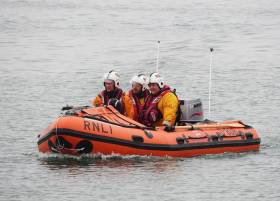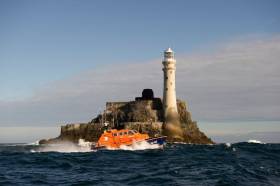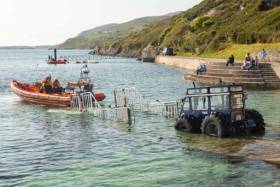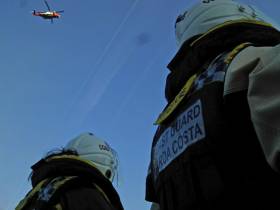Displaying items by tag: Medevac
#RNLI - Baltimore RNLI launched twice in the space of a few hours yesterday (Friday 29 December) — firstly to provide a medevac from Heir Island, and later to assist bodyboarders in difficulty at Barleycove.
The volunteer crew launched their all-weather lifeboat Alan Massey following a request from the Irish Coast Guard at 11.16am to provide medical assistance and evacuation to a woman who fell on Heir Island off the coast of West Cork.
Once on scene, the crew administered casualty care before transferring the patient to the all-weather lifeboat and returning to Baltimore to meet a waiting HSE ambulance crew.
Conditions at sea during the shout had a north-westerly Force 6-7 wind and a one-metre sea swell, heralding Storm Dylan’s approach this weekend.
The crew launched a second time, at 4.18pm, after a member of the public alerted that three bodyboarders were in difficulty off Barleycove, near Mizen Head in West Cork.
The wind had eased considerably since the first callout, with a south-westerly Force 3-4, but there was a rough sea state with a swell of 3-4m.
At 4.45pm, with the lifeboat four miles west of West Calf Island, the crew were asked to stand down by the Irish Coast Guard after the three bodyboarders had made it safely ashore.
Speaking following the callouts, Baltimore RNLI volunteer lifeboat press officer Kate Callanan said: “With strong winds forecast over the coming days, the Irish Coast Guard strongly advises to exercise caution in coastal areas and reminds people to ‘Stay Back, Stay High and Stay Dry’.
“If you see someone in difficulty in the sea of along the shore call 999 or 112 and ask for the coastguard.”
The volunteer crew on the first callout were coxswain Kieran Cotter, mechanic Jerry Smith and crew members Aidan Bushe, Don O’Donovan, Simon Duggan and Kieran Collins. Ay the lifeboat station were Kate Callanan and John O’Brien. Crew on the second callout were Cotter, Smith, Bushe, O’Donovan, Eoin Ryan and David Ryan.
Elderly Passenger In Medevac From Queen Mary 2 Off Cork
#Medevac - Shannon’s Irish Coast Guard helicopter Rescue 115 was involved in a medevac from the cruise liner Queen Mary 2 some 60 nautical miles off West Cork on Thursday morning (12 October), as BreakingNews.ie reports.
An elderly passenger understood to have a heart problem was treated by the ocean liner’s medical staff before transfer to the coastguard crew, who airlifted him to University Hospital Tralee.
Coastguard Medevac Alerts In West Cork & Dublin
#Coastguard - Castletownbere’s Irish Coast Guard team was alerted on Friday night (29 September) by Valentia Coast Guard to a medevac scheduled for the early hours of Saturday.
FV Argeles, a French fishing vessel, had an injured crewman onboard and was expected in Castletownbere some hours later.
The coastguard crew and Castletownbere HSE ambulance were waiting for the trawler when it docked at 2.40am. The two crews worked together to assess and stabilise the casualty, who had sustained back injuries after a fall.
After the casualty had been transferred to the ambulance, they were taken to Cork University Hospital for further treatment. The coastguard team were stood down at 5.10am.
Elsewhere, the Marine Rescue Coordination Centre in Dublin received a request for assistance from a yacht off the coast of Malahide on Thursday afternoon (28 September).
A crew member aboard the yacht, which was en route to Dun Laoghaire Marina, was ill and required medical attention.
It was agreed that the yacht would continue to its destination. RNLI Dun Laoghaire was sent to provide an escort and also dropped crew aboard to assist.
On arrival to the marina, Dún Laoghaire Coast Guard members greeted the yacht alongside HSE paramedics and gardaí. The ill crew member was transported to hospital for further medical attention.
Long-Range Medevac For Sligo Coastguard Helicopter From Cruise Liner ‘Marco Polo’
#Coastguard - The Sligo-based Irish Coast Guard helicopter Rescue 118 conducted a medevac for a passenger on board the cruise liner Marco Polo this morning (Wednesday 27 September).
Malin Rescue Coordination Centre received an early morning request from the UK Maritime and Coastguard Agency (MCA), who requested the Irish Coast Guard to assume coordination of the operation.
The rendezvous with the ship took place around 190 miles west of Erris Head shortly before 8.30am. Rescue 118 was expected to arrive with the casualty at University Hospital Galway before midday.
An Air Corps Casa maritime patrol aircraft was made available to provide communications and surveillance back up, known as ‘top cover’ but had to be redeployed to conduct two separate patient transfers to UK on foot of a request from the National Ambulance Service. This role was reassigned to the Dublin-based coastguard helicopter Rescue 116.
Weather conditions at the time were described as reasonable.
#ClipperRace - A Clipper Race yacht is diverting to Portugal after the team’s skipper suffered a serious injury to his left hand that required emergency medical attention.
Greetings skipper David Hartshorn got his left thumb caught in a spinnaker sheet while leading a drop of their code 3 heavyweight kite in breezy conditions on Saturday night (26 August), with wind blowing between 18 and 22 knots some 450 nautical miles off the Portuguese coast.
Hartshorn received treatment from team medic Miles Berry, a surgeon doing Legs 1 and 4, who also liaised with the race’s remote medical support physicians PRAXES ahead of the skipper’s helicopter medevac yesterday afternoon (Sunday 27 August).
“An agreed medevac procedure was put into place where David was lifted from the water rather than from on deck and the manoeuvre went really well,” said Clipper Race director Mark Light.
“The Greenings crew have been incredible and have remained composed throughout. They are now motoring directly to Porto under the command of Clipper Race coxswain and round-the-world crew member Jeremy Hilton.”
Deputy race director Daniel Smith is in constant communication with the crew and will receive regular updates.
Tomorrow morning (Tuesday 29 August), Greenings is expected to reach Porto, where the race crew will be met by Clipper Race officials who will advise on the next steps.
Meanwhile, the rest of the Clipper Race fleet has split into two clusters as they pass Portugal en route to South America.
On the westerly course, GREAT Britain, Liverpool 2018 and HotelPlanner.com took the gamble of adding extra miles to their route, but making up for it with more favourable wind conditions.
They’re also gaining significant time on the leaders further east, who have suffered from a wind hole over the weekend.
Indeed, the western option has paid off exceptionally well for HotelPlanner.com, skippered by Derry-Londonderry man Conall Morrison, which leapt to fifth place in the latest standings (as of 8am on Monday 28 August) and is holding sixth overall.
The weather for the week ahead looks more promising for both groups as they converge for the swing past the Azores.
Wicklow Lifeboat In Medevac For Injured Sailor
#RNLI - Wicklow RNLI’s inshore lifeboat launched yesterday afternoon (Sunday 20 August) to assist Wicklow Ambulance Service with the medevac of a sailor who sustained injuries while sailing in the bay.
The lifeboat crew, comprising helm David O’Leary, Graham Fitzgerald and John Stapleton, transferred the casualty from the yacht at the east pier to the nearby slip, where they were met by a waiting ambulance crew.
#RNLI - Baltimore RNLI’s volunteer lifeboat crew has responded to three callouts over the last four days.
The first of the three was a medical evacuation from Cape Clear on Friday (7 July).
A woman from the island was suffering from chest pains and needed to be transferred to the mainland, where she was met by a waiting ambulance at the lifeboat station.
The lifeboat was crewed by Kieran Cotter, Sean McCarthy, Cathal Cottrell, Aidan Bushe and Don O’Donovan.
The following night (Saturday 8 July), the lifeboat carried out another medevac, this time from Sherkin Island after man suffered a serious fall from a height and required medical assistance.
The lifeboat crew were assisted on the island by a team led by Dr Jason from West Cork Rapid Response.
The casualty was evacuated to Baltimore, where an ambulance was waiting at the lifeboat station for transfer to hospital in Cork.
Crew on this callout were Kieran Cotter, Pat Collins, Jerry Smith, Don O’Donovan, Brian McSweeney, Jim Griffiths and Ronnie Carthy.
Finally, yesterday morning (Sunday 9 July) Baltimore RNLI’s inshore lifeboat was launched to go to the assistance of a RIB which had broken down off Cape Clear.
Mícheál Cottrell, a helm and crewman with Baltimore RNLI, was out with his sea safari boat on a tour with passengers when he happened upon the boat, with two people onboard, which was suffering engine problems.
Cottrell raised the alarm and Baltimore’s inshore lifeboat was requested to assist.
The lifeboat took the boat in tow to Baltimore, where it was berthed safely and the lifeboat returned to station.
Crew on the inshore lifeboat were helm Youen Jacob, David Ryan and Ryan O’Mahony.
Shore crew in assistance at Baltimore Lifeboat Station were Declan Tiernan, Sean McCarthy, Rianne Smith and Marty O’Driscoll.
Two Medevacs For Clifden Lifeboat Since Friday
#RNLI - Clifden RNLI has carried out two medical evacuations from the island of Inishbofin off Connemara since Friday (23 June).
The pagers first sounded at 11.15am on Friday in response to a call for the medevac of an elderly woman in need of hospital treatment.
Clifden's D Class inshore lifeboat and crew were already on the water in Clifden Bay carrying out a scheduled exercise when they were called to transfer to the Atlantic 85, helmed by Joe Acton, that arrived at the island before the Irish Coast Guard helicopter Rescue 118, which was also tasked.
Lifeboat crew member Sinead Pryce assisted the casualty, and the lifeboat and helicopter worked together to ensure a seamless transfer.
The following morning (Saturday 24 June), pagers once again sounded shortly after 7.15am after a woman on Inishbofin had become suddenly unwell.
The all-weather boat Fisherman’s Friend was requested to respond and a crew was assembled including coxswain Alan Pryce, mechanic Robert King, navigator Owen Hayes and crew Brian Ward and Neil Gallery.
The casualty was transferred to the all-weather boat by the crew and island nurse and taken to Cleggan Pier where an ambulance was waiting.
Speaking following the callouts, Clifden RNLI lifeboat operations manager John Brittain said: “It has been a busy summer week for the Clifden lifeboats with three launches taking place involving our different boats in different scenarios.
“I want to thank the crew for responding to their pagers promptly in these cases so that we can continue to carry out this vital service in our local community.”
#Skibbereen - TheJournal.ie reports that a 14-year-old boy is in critical condition after he was struck in the head by a boom while yachting off Skibbereen yesterday morning (Saturday 24 June).
The teenager was airlifted to Cork University Hospital by the Irish Coast Guard helicopter Rescue 117, and the latest news from Independent.ie is that his condition was improving.
Elsewhere yesterday, Howth Coast Guard attended a 53-year-old man with serious head injuries sustained while kitesurfing off Sutton in North Co Dublin.
And Shannon’s Rescue 115 was called to Inis Mór in the Aran Islands for the medevac of a woman who suffered spinal injuries while taking part in the Red Bull Cliff Diving World Series event.
#Rescue - A tanker crewman was airlifted to hospital from the Port of Cork yesterday evening (Saturday 17 June) after sustaining a leg injury on board his vessel, as the Irish Examiner reports.
The Waterford-based Irish Coast Guard helicopter Rescue 117 was dispatched for the medevac of the casualty, who is thought to have broken his leg after a cable or rope snapped, after the local fire service was unable to remove him safely.
The Irish Examiner has much more on the story HERE.






































































